How To Build Corrugated Metal Raised Garden Beds

One of our huge undertakings for our 2018 vegetable garden was building brand new galvanized steel raised garden beds. It was our sixth growing season working this space, and that year, we decided it was time to invest in our "forever" beds.
When we first started growing in this space, we had planned on growing in wide raised rows in our garden space like is suggested in one of our favorite gardening books—in fact, we even spent one fall digging them throughout our entire growing space—but it didn't work out for us for a few reasons. The main issue was that we have a wicked weed seed infestation in our garden soil. We've tried fighting it with mulch and a lot of back-breaking weeding, but we ended up losing the battle every year. We decided something had to change—and building raised beds with fresh soil was it.
Download the FREE Printable Plans
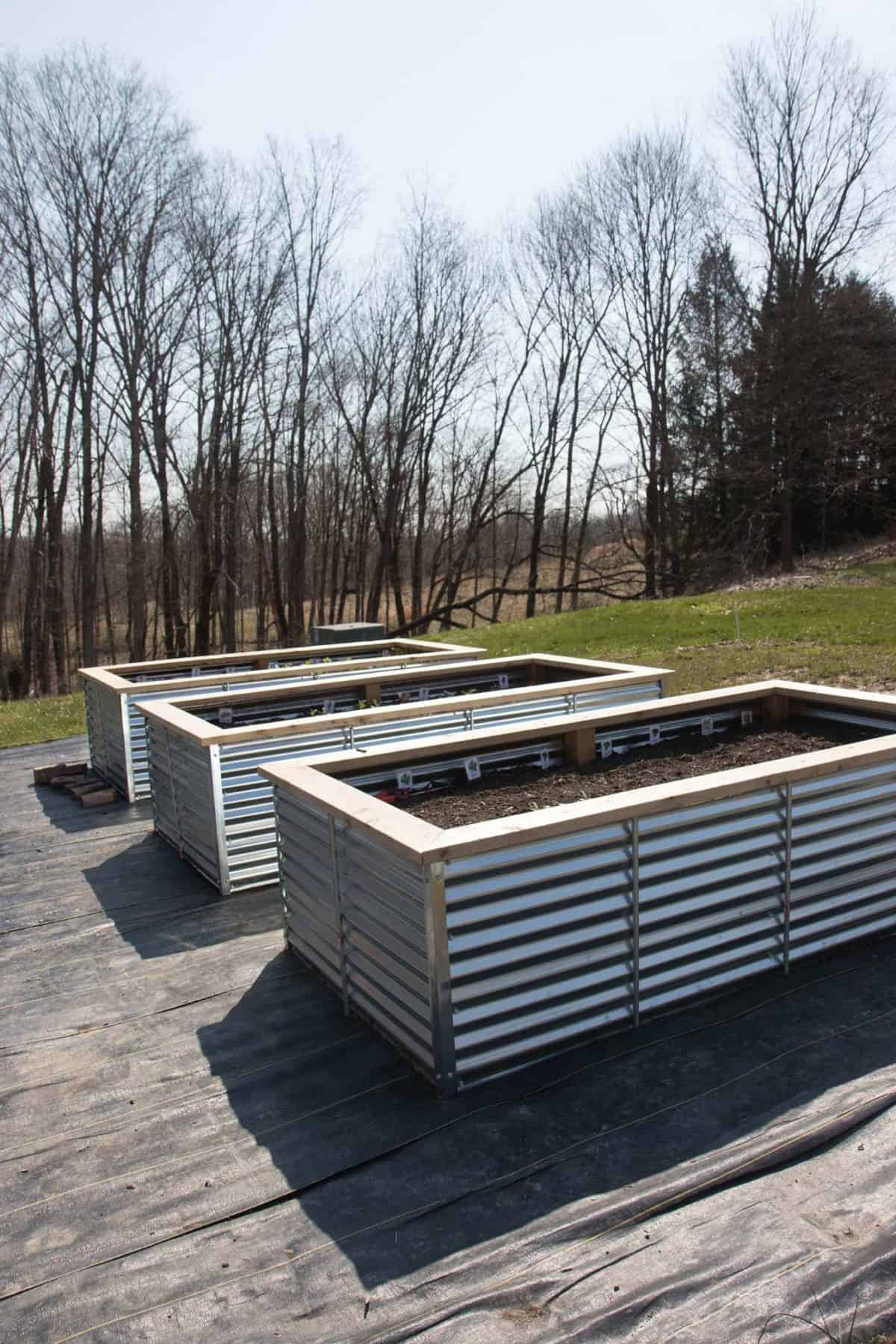
Why did you choose raised beds gardening?
Of course, weed control isn't the only benefit of raised garden beds. We've always had amazing success growing in raised beds because you have so much control over the growing environment—it's easy to control the watering, the fertilizing, and the pests. They also look beautiful, and since we ended up making our raised beds so high, they make any garden work easy on the back and the knees.
There are some negatives to raised bed gardening though. The main one is that it dramatically reduces your growing space. You just can't cultivate the same number of plants you would be able to if you took the same space and make wide rows.
The other big hiccup: it's expensive to build raised garden beds. Tilling up a plot of land and planting some seeds is relatively cheap (or even free), but once you start adding in building materials to build raised beds and soil to fill them up—it can get pretty pricey.

What are the pros and cons of different types of raised beds?
So we considered the pros and cons of all methods of cultivating our garden, and in the end decided that nice, long-term raised beds were where we wanted to invest our gardening budget this year. Once we had decided that raised beds were the way to go, we had to do some decision making on what materials to build them out of. Here were the main contenders:
- Treated lumber: This is a pretty standard way to build raised beds—a lot of folks use treated lumber (and in fact, our previous raised beds were treated lumber). We didn't want to go this route for one reason: the chemicals they use to treat lumber freak me the hell out. And the idea of those chemicals being in close proximity to the garden soil that I grow my organic vegetables in for 20+ years? Well, something just wasn't adding up there. This would have been the cheapest option (closer to $75 per bed), but in the end, we decided that if it's important enough for us to invest in buying organic vegetables from the grocery store, it's important enough for us to invest in raised garden beds that aren't (possibly) going to leach dangerous toxins into the precious soil we grow our food in.
- Cedar lumber: This was where we went next. Cedar is naturally rot-resistant (for 15-20 years, I've heard). It weathers beautifully, smells wonderful, and is easy to get. The only problem? Holy crapoli, is it pricey. Doing a full cedar bed the height we wanted was going to be upwards of $300 per bed. That just wasn't feasible for us.
- Galvanized steel roofing panels with treated lumber frame: I'd started to see the Corten Steel planters all over Instagram—and while they are beautiful, their price and aesthetics aren't quite right for our garden space. But they did give me the idea of using galvanized steel roofing panels! We used them on our chicken coop, and we loved working with the panels so much, that we knew we'd use them again somewhere. They are affordable, readily available, and beautiful! We started doing some research about using them as raised beds, and a number of people have done it, but because the panels are thin and bow when filled with soil, you need to build a full lumber frame (with supports inside) to support them. When we priced this out, it was barely any cheaper than the cedar route, it was going to take a lot of time to build the frames, and we still had the dreaded treated lumber touching our soil. Back to the drawing board.
- Galvanized steel roofing panels with cedar and conduit supports: I refused to give up on the steel panels, so I kept Googling and Googling to try to find someone who had made a bed without the treated lumber frame. I landed on this post from the Prairie Homestead. They didn't use a frame, but her beds use steel bridge decking, which is thick enough not to bow with the soil. The panels are not something you can just head to Lowe's and pick up, and it's not cheap. We nixed that pretty quickly. Then! Then! I found this post where they buried conduit in the ground to support the side panels, and then used 4″ x 4″ supports in the corners. WE HAVE A WINNER! My husband ended up fashioning a plan based on those pictures where we use 4″ x 4″ cedar supports in the corners and middle of the bed, the panels are screwed to those supports, and then we sunk metal conduit on the sides to support the beds. These beds cost us right around $150 per bed to build (before soil, with 2017 prices).
I'm going to give you a full tutorial for how to make these raised garden beds at the bottom of this post, but first, I've been getting a lot of questions about these beds, so let me answer those.
Why did you choose to put landscape fabric under the bed?
Moles. And weeds. Moles and weeds are jerks. And we have a lot of both them. Moles love to burrow through our garden and just destroy our garden beds, so we're hoping the long-life landscape fabric we used will keep them out. Same with the weeds, to a lesser extent. Most weeds won't be able to germinate up through two feet of soil, but honestly, our weeds are so relentless, I wouldn't put it past them. So we erred on the side of too much weed control as opposed to too little. We will be covering all the landscape fabric with crushed or pea gravel later in the season.
Landscape fabric is a necessary evil for us. I don'tlovehaving a petroleum-based product at the bottom of our beds, but I think if we didn't put it down, we would have been kicking ourselves for years. We investigated some other weed and mole control methods, but none of them seemed as sure as landscape fabric (by the way, this is the weed fabric we always use—it's really great quality and, if you have a Prime account, Amazon is the cheapest place we've found to buy it and get it shipped). I take some comfort in the fact that the fabric is below two feet of soil—hopefully any chemical leaching the fabric does will leach down and not up.
One thing we did have to adjust because of the fabric—we had to bring in worms! Worms probably would have eventually found their way through the seams of the fabric into our beds, but we sped up the process a bit by inoculating our beds with nightcrawlers from Uncle Jim's Worm Farm.
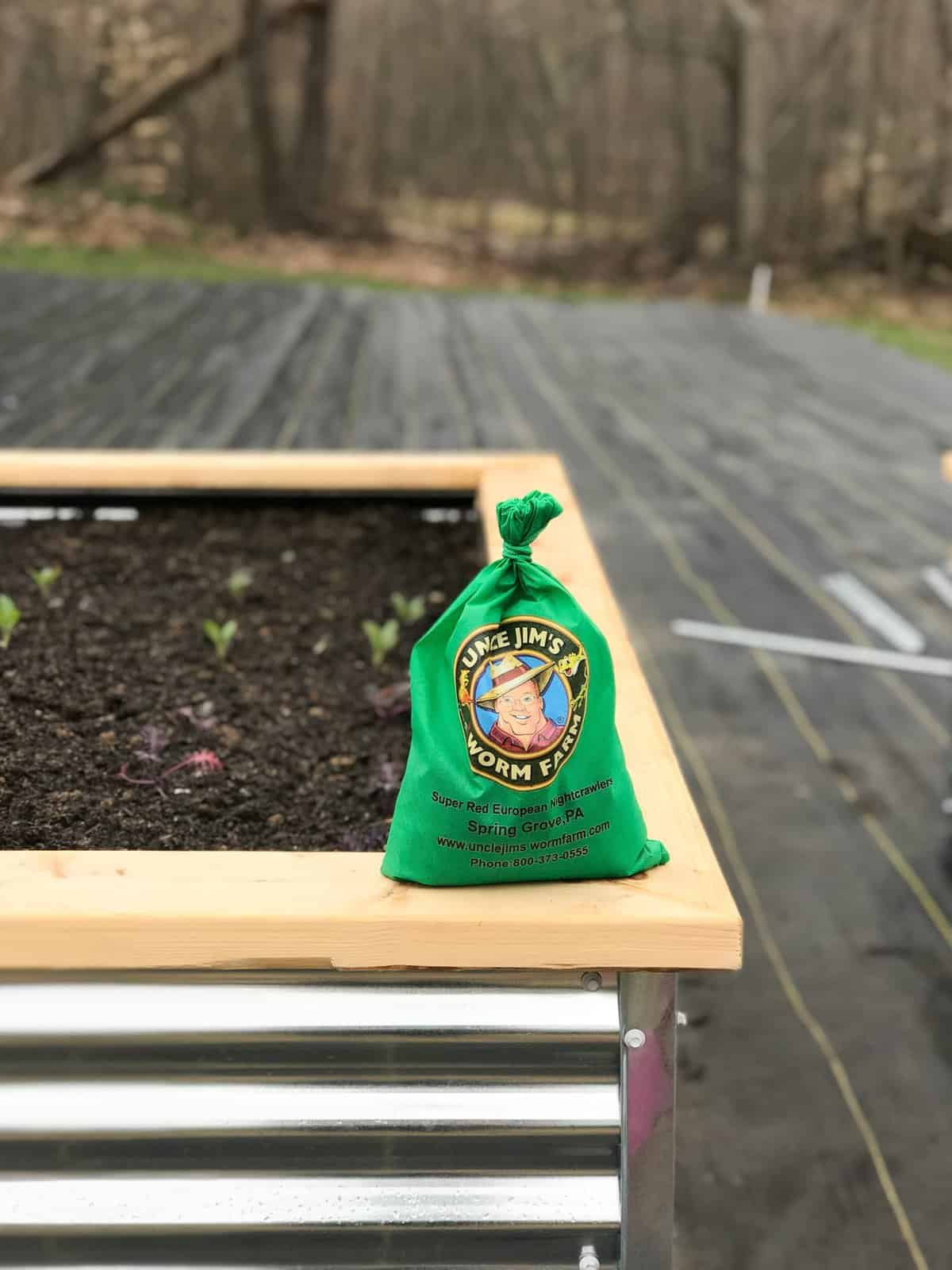
Why did you make the beds so deep?
The depth of our beds is 26″—the same as the width of the galvanized steel roofing panels. Could we have cut them down to make shorter beds? Absolutely, but we didn't want to for a few reasons. The obvious one is that a higher bed makes for less back-breaking work. Our beds are high enough that we can comfortably sit on the sides and weed or bend over to harvest without feeling like our knees and backs are taking a beating. This isn't a huge deal right now since we are in our mid-thirties, but since we want these to be long-term beds, we were thinking about future Cass and Craig. In 10, 15, 20 years, I think we'll be thanking our past selves for making higher garden beds.
The second main reason is that plants wantwaymore soil than you imagine they would. They like lots of space for their roots to spread out—especially plants with long taproots like carrots. Honestly, the more soil space you can give your plants, the happier they'll be.
The only con to these mega deep beds is the amount of soil you need to fill them. We brought in weed seed-free soil and compost from a local company, and the volume just makes it a lot more expensive. But thankfully, it's a one time expense.
How long do you think these will last?
The galvanized steel panels, conduit, and corner covers will last 30-60 years. The cedar supports will probably be a bit less—closer to 15-20 years. If we get 20 years out of these babies, I'll be thrilled.
Do you have a cold frame to use with these?
Yes, and it's laughably simple! We didn't fill our beds 100% to the top with soil—we left about six inches clear—so we can cold frame the beds without much effort at all. Literally, our "cold frame" is just a plastic greenhouse panel laid on top with some bricks to hold it down.
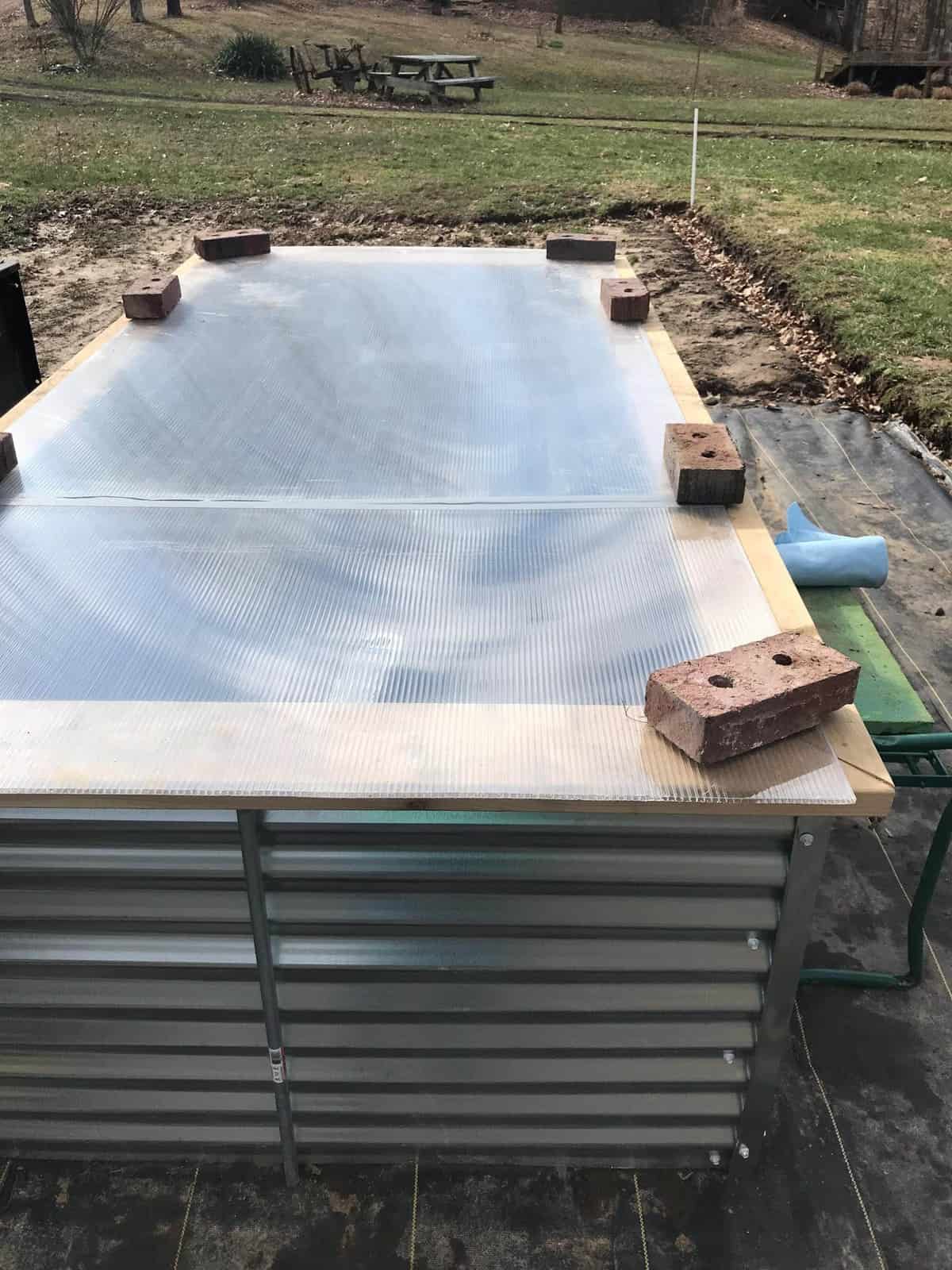
This works so well, it's amazing! On a 30°F and sunny day, it was up to 75°F in the bed within about five minutes of putting the panel on. The best part about this? It was totally free. We screw these panels into the side of our chicken coop in the winter to act as a windbreak in their run—so when we took them off for spring, we just moved them onto our garden beds!
Don't these raised beds get too hot in the summer? Aren't you baking your roots? Do you have to water all the time?
Nope. While these raised beds are metal, they are reflective metal, which means they don't absorb nearly as much heat as you might imagine—in fact, during our hot and humid summers here in Zone 6B, the soil in these beds is often cooler than soil in other containers around our property. We don't have to water any more often than we did with wooden raised beds, we've never "baked" our roots, and we've never burned ourselves on the metal. We frequently work in and around these beds on 90-100°F sunny days, and the metal is usually about the same as the air temperature—if not a touch cooler.
What did you fill your garden beds with?
We had a big dump truck load of half garden soil and half organic compost delivered to our house. The garden soil is a mixture of screened topsoil and sand (to help with drainage). We then tested the soil and amended it as necessary in each bed. Each year, we top dress the beds with more compost and worm castings.
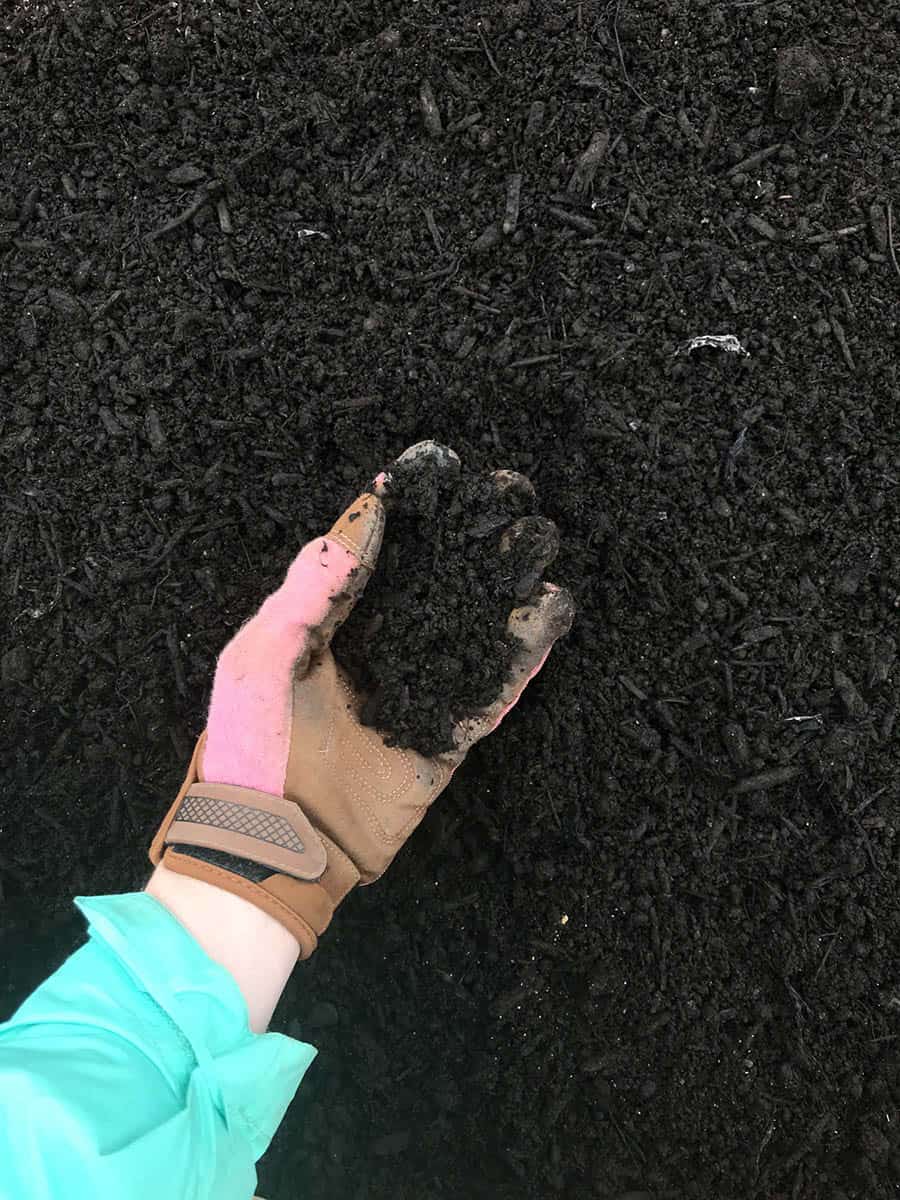
How to Build Galvanized Steel Raised Garden Beds
Download the FREE Printable Plans
Materials List for a single 8′ x 4′ bed
Click any item to see an example and/or purchase online.
- 2—8′ x 4″ x 4″ cedar boards (AKA: cedar fence posts/timbers)
- 3—10′ x 2″ x 6″ cedar boards
- 3—8′ corrugated galvanized roof panels
- 3—10′ lengths of 1/2″ galvanized conduit
- 1—1 1/2″ x 10′ galvanized roof edge (this is located with gutters)
- 1 pound box—1″ self-drill screws with washers
- 1 pound box—3″ exterior (deck) screws
Tools List
- Miter saw
- Short-handled sledge hammer
- Drill
- #2 Phillips drill bit
- 5/16″ hex-head nut driver bit
- Ratcheting tube/pipe cutter
- Tin snips (or circular saw with metal cutting blade)
- Tape measure
- Medium grit sandpaper
- Pencil for marking cuts
Cut List
- 6—26″ lengths of cedar 4″ x 4″ using miter saw
- 2—99 3/4″ lengths of cedar 2″ x 6″ (from TWO 10′ boards), ends cut inwards at 45 degrees using miter saw
- 2—51 3/4″ lengths of cedar 2″ x 6″ (from ONE 10′ board), ends cut inwards at 45 degrees using miter saw
- 4—26″ lengths of roof edge using tin snips
- 8—40″ lengths of conduit using tube/pipe cutter
- 1 —corrugated roof panel cut in half widthwise using tin snips/circular saw
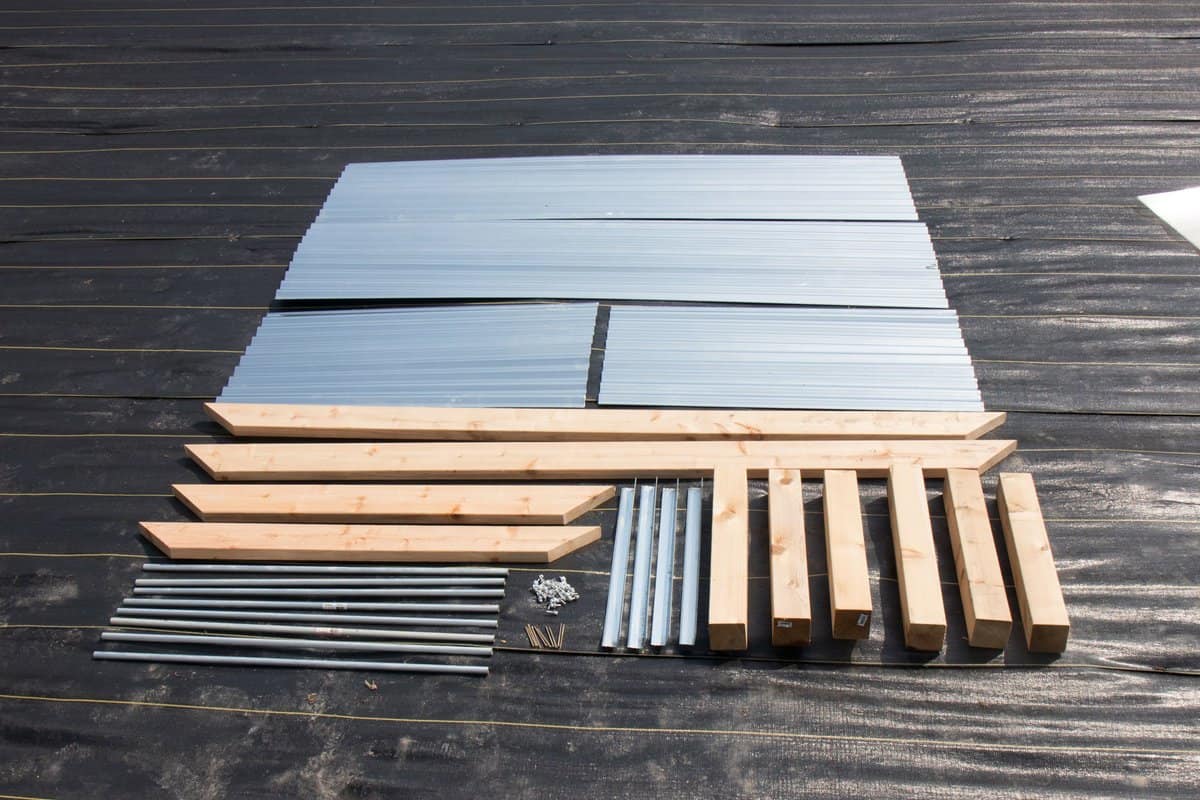
Instructions for Building Raised Garden Beds
1. On a flat surface big enough for a 8′ x 4′ raised bed, lay down two 26″ x 4″ x 4″ cedar boards parallel to each other roughly 8′ apart (photo 1A).Take one 8′ corrugated panel, and place the panel so that it rests on top of your 4″ x 4″ pieces at each end, like a bridge—making sure the outside edge of the panels curve upward and the edge of each panel is flush with the edge of the 4″ x 4″ (photo 1B).Using four of the 1″ self-drill screws for each end, screw the panel to the 4″ x 4 " piece, starting at the top groove of the panel and skipping two grooves for each screw (photo 1C).Repeat this step with your other 8′ corrugated panel and two more of the 26″ x 4″ x 4″ pieces (photo 1D).

2. Have someone assist you by lifting up one of the previously assembled panels and holding it in an upright position (photo 2A). Take one of the half-cut corrugated panel and place it against either end of the assembled 8′ panel, creating a 90-degree corner of your bed (photo 2B). Using four more 1″ self-drill screws, screw it into the 4″ x 4″ through the top ridge of the panel, skipping two ridges for each screw, just as previously done (photo 2C). Repeat this step with your other half panel on the other end, creating another corner of your bed (photo 2D).

3. Have your assistant lift the other 8′ assembled panel and hold it in place between the two half panel ends to create the other side of your bed and the other two corners of it (photo 3A). Screw through the half panels and into the 4″ x 4″ corner supports on the assembled 8′ side your assistant is holding (photo 3B). You should now have a four-sided 4′ x 8′ raised bed. Place your bed as it currently is in the location that you want it to be permanently (photo 3C).

4. Grab the eight 40″ lengths of conduit, tape measure, and sledge, as you will now be anchoring your bed in place. Start by measuring the halfway point on any side (photo 4A). Getting as close to the panel as possible, start hammering in one of the pieces of conduit into the ground at this point to about a 6″ depth (photo 4B). Repeat this step on the other three sides and then make sure your bed is still placed the way you want it, as you may have shifted it slightly when you started hammering in the conduit. Adjust as needed. On one of the 8' sides, measure the halfway point between the previously hammered conduit and the end of the bed and hammer another length of conduit here (photo 4C). Do this on both sides of the originally hammered conduit. Repeat on the other 8′ side. Hammer all conduit in until the tops are level with the top of your corner 4″ x 4″ posts (photo 4D).

5. Take your two remaining 4″ x 4″ pieces and place these in the middle of each 8′ panel on the inside of the bed, for added support of the top rails (photo 5A). Place the 4″ x 4″ on the inside, just to the left or right of where the conduit is on the outside, and screw in using your 1″ self-drill screws (photo 5B). Repeat on other side (photo 5C).

6. To do the top rails, place one of your 99 3/4″ x 2″ x 6″ rail pieces on top of the 4″ x 4″ supports on the 8′ side (photo 6A). Make sure the inside edge matches up with the inside corner of the 4″ x 4″ corner post (photo 6B). Using one to two 3″ screws per 4″ x 4″, fasten the rail into the 4″ x 4″ (photo 6C). You may run into an issue regarding your conduit sticking up too high. Just lightly hammer the 2″ x 6″ rail until it is able to rest upon the 4″ x 4″ supports.

7.Next, place a 51 ¾″ board on one end so it hugs the 45 degree angle of the top rail that was just fastened (photo 7A). Using 3″ deck screws, fasten this board to the corner and middle 4″ x 4″ supports (photo 7B). Then, place both the remaining 99 3/4″ top rail and the 51 3/4″ top rail at the same time (photo 7C). Wiggle and adjust them so they can fit snuggly into the already fastened rails. Once they are flush, fasten them to each corner support and the two middle supports with 3″ deck screws (photo 7D).

8. Attach the galvanized roof edge to each corner to prevent injury from the edges of the sharp roof panels (photo 8A). Each 26″ corner piece will require four of the self-drill screws to fasten it, two at the top of each side and two at the bottom of each side into the corners of the bed (photo 8B). Repeat with all four corners (photo 8C).

9. The finishing touch is to sand down your cedar top rails to ensure that no splinters are going to happen when sitting on your beautiful new cedar/galvanized raised beds (photo 9A). Then fill up your bed with soil, plant, and enjoy (photo 9B)!

Download the FREE Printable Plans
Happy planting, friends!
Update: One Year Later!
We're still in love with our raised garden beds. They got us beautifully through one growing season, and we're starting another one soon. We have placed #11 limestone gravel between our beds and have been very happy with it. We can't wait to save up some cash to finish out the beds. Here are some photos from our first growing season:
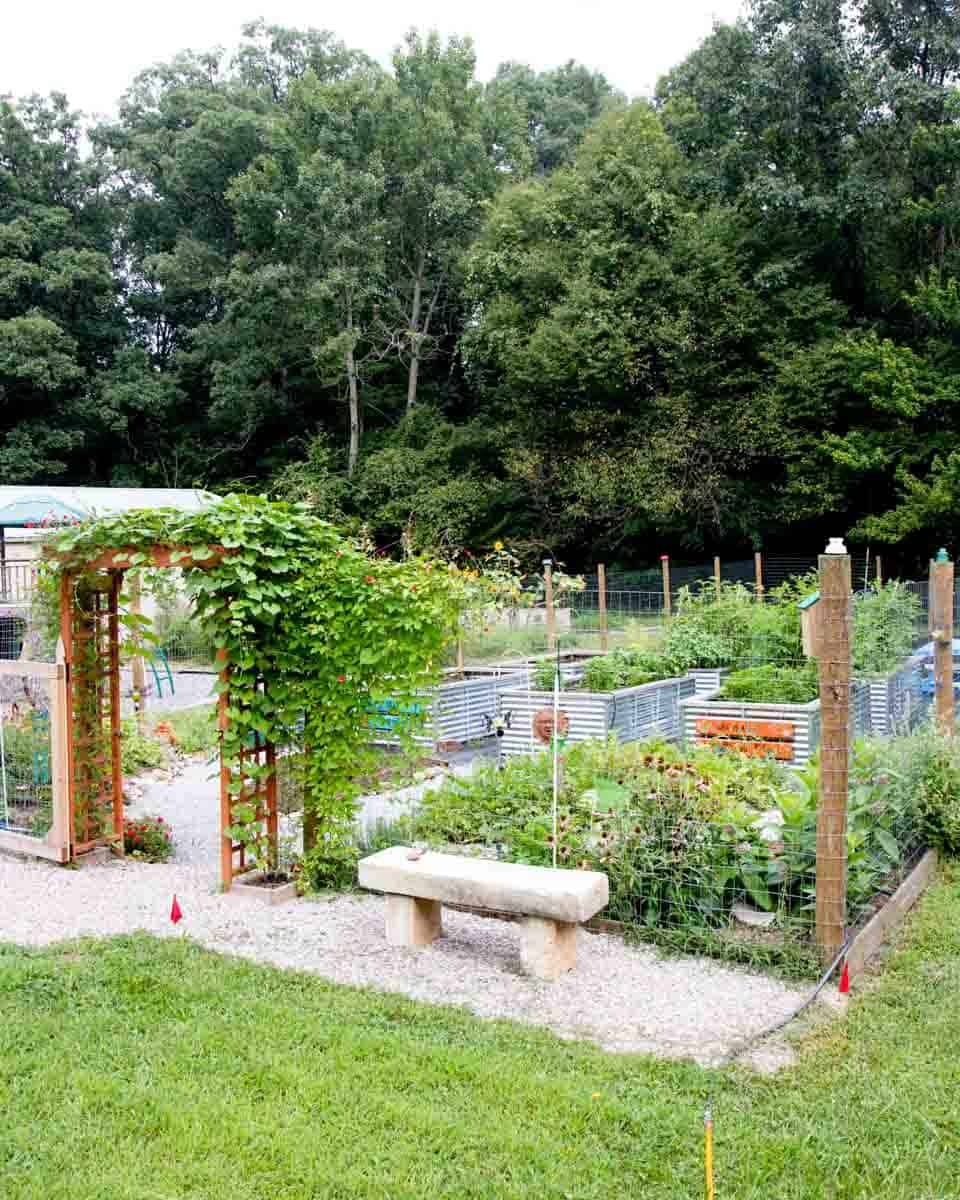

Update: Three Years Later! (spoiler alert: we still love our raised garden beds!)
We're heading into our third growing season with these raised beds, and we still love them! There is nothing I would change about the design itself or the materials—in fact, we've built more beds each year because we love them so much! We have made two very minor changes (one structural, one cosmetic) from this original plan–they aren't necessary changes, but they improved the design for us:
We sealed the cedar tops
After three years of Midwestern weather, the tops of the beds started to get the gray, weathered look cedar tends to take on. I personally prefer the beautiful red color of cedar, so I took it upon myself to sand the tops and seal with a natural, water-based exterior sealer (this is what I used in Lakeside Cedar). Unsealed cedar will last ages, so this is almost entirely an aesthetic decision. It makes me smile. I know I'll have to redo it on the regular, but I much prefer the look of the beds this way.
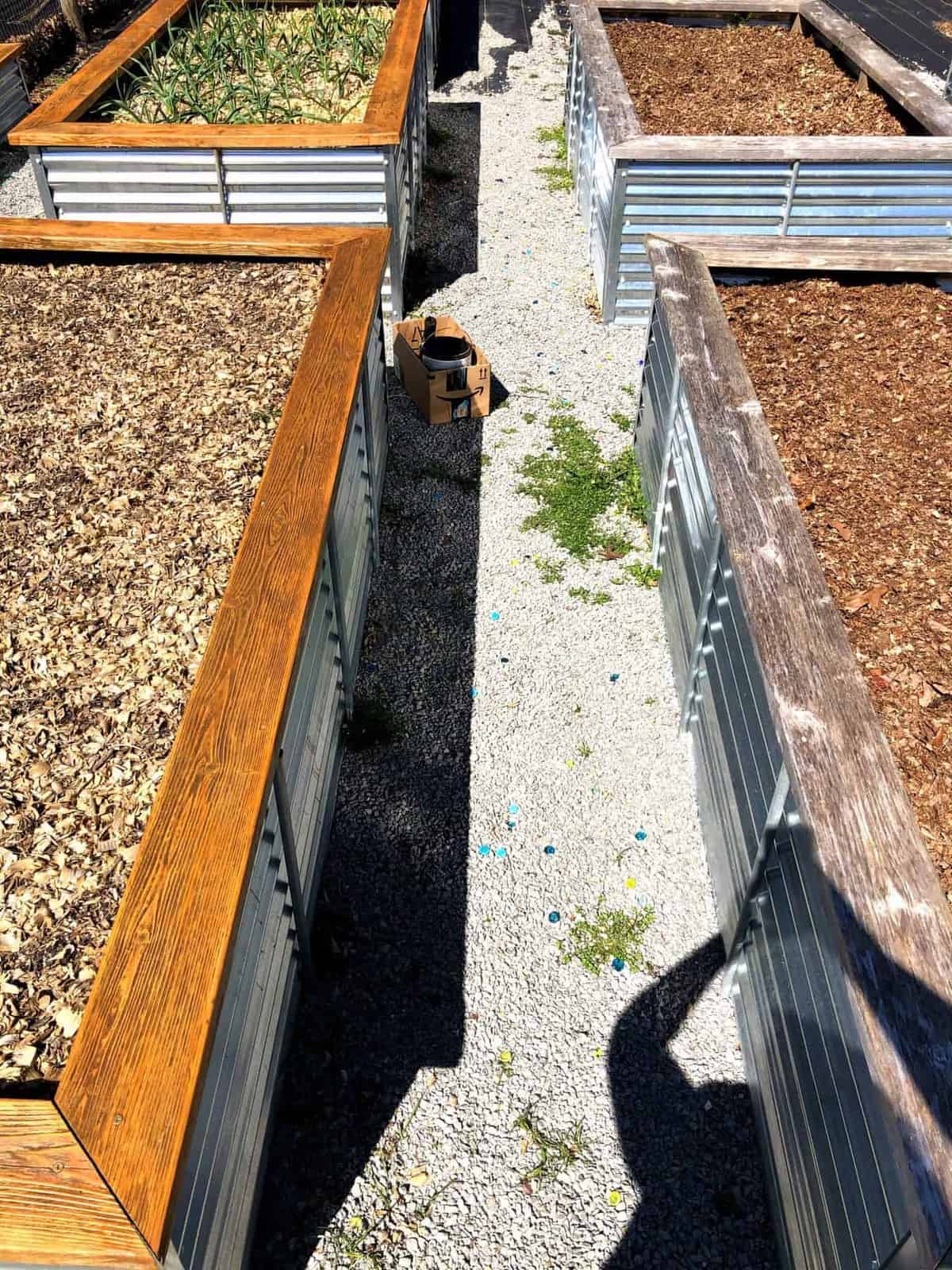
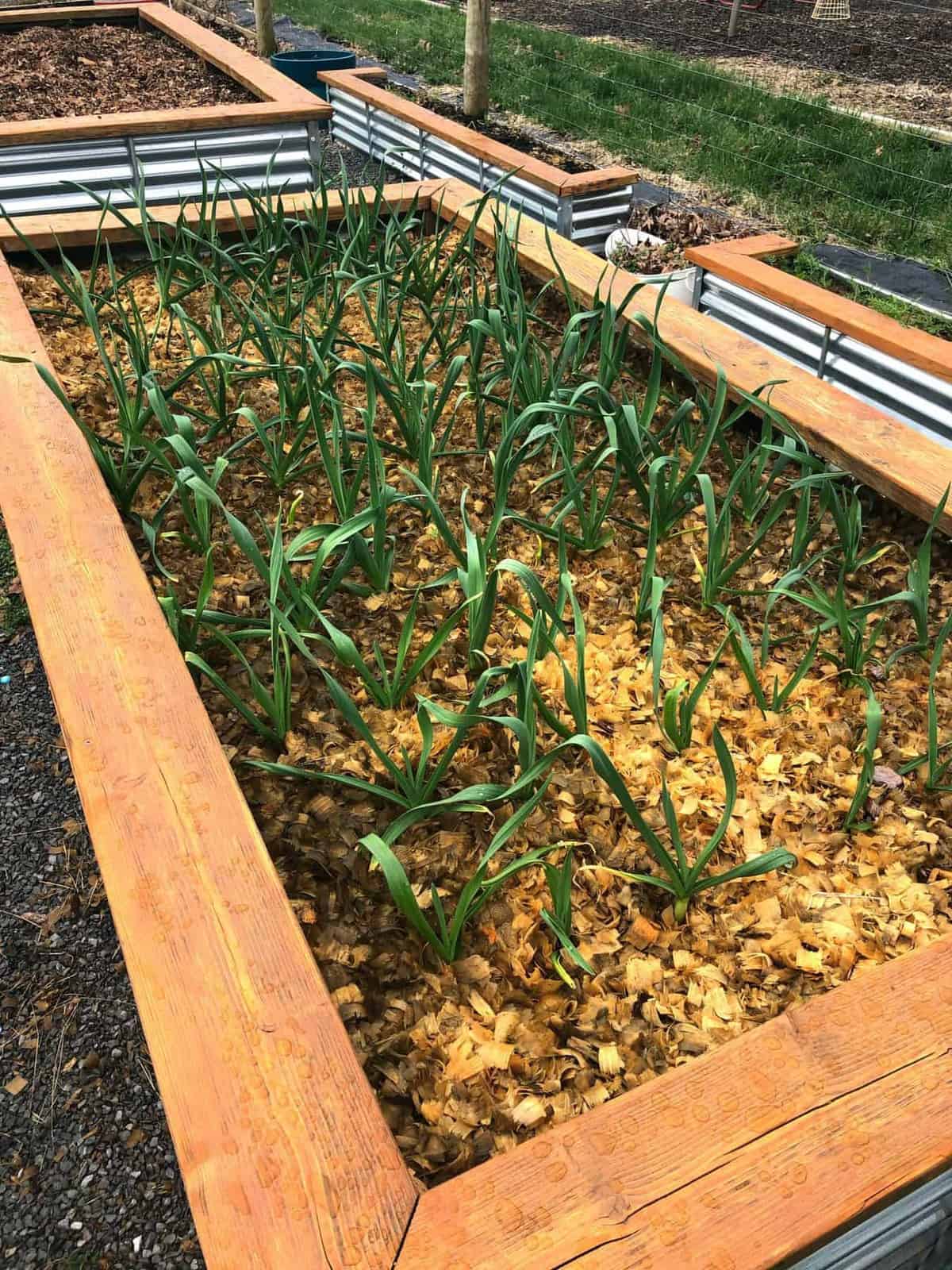
We sunk 3″ screws through the tops of the raised beds directly into the hole of the conduit.
We had no problems with our beds bowing during the warm weather months, but in the winter, when the soil was frozen, we had some slight bowing issues with the conduit. It wasn't a huge structural deal (and it mostly popped back into place when the soil warmed up in the spring), but the tops of the conduit were a bit sharp/scratchy and we have a small child who climbs all over the beds—so we went ahead and dropped the screws in to hold the conduit in place. Now the conduit doesn't budge!
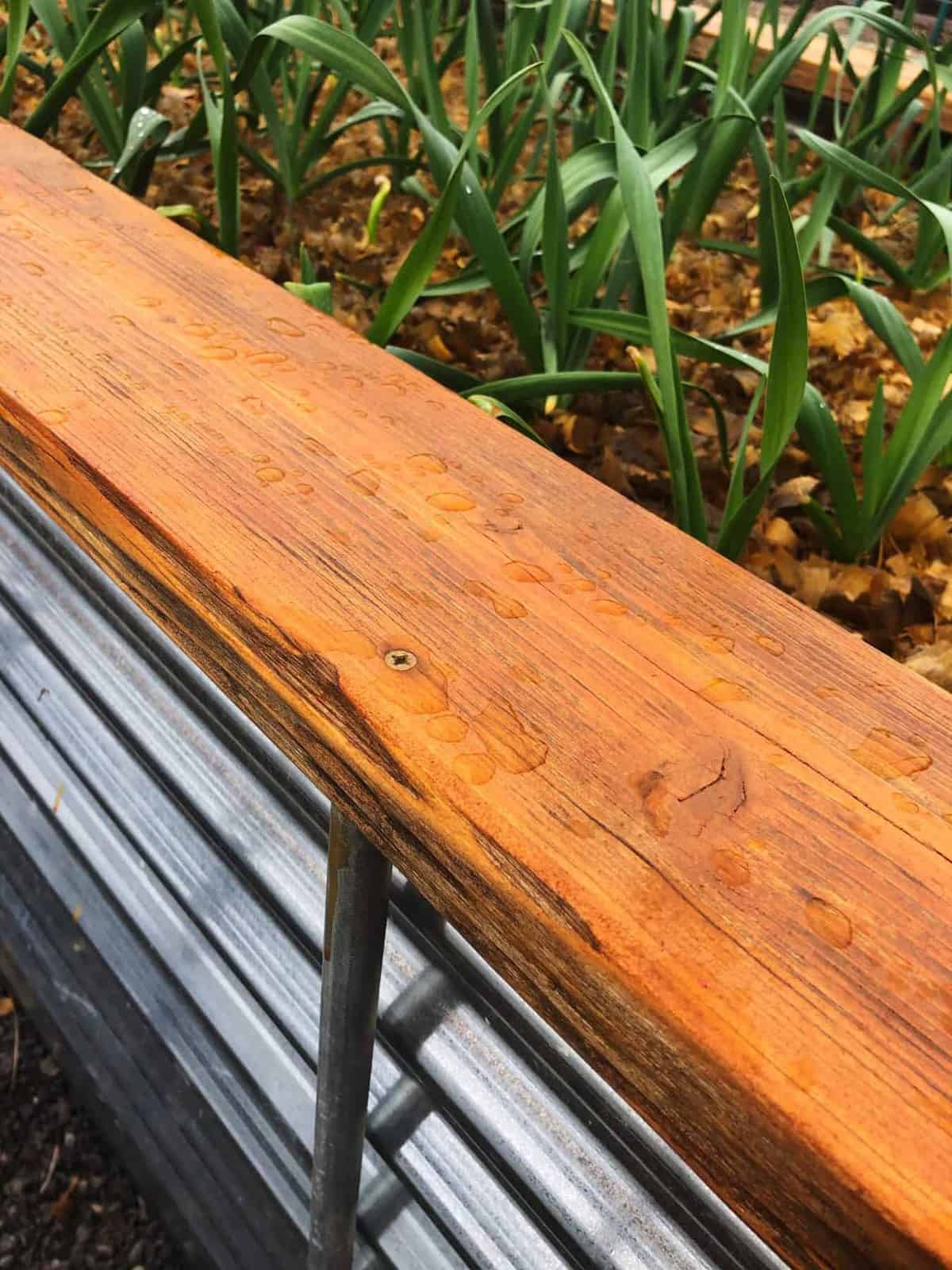
The other changes we've made are less about the beds themselves, and more about our garden placement/method:
- In our original six beds, we used landscape fabric under the entire beds to keep out weeds. With beds we've added since, we've cut the fabric out of the bottom (and folded it up the side of the bed) to allow more interaction with the natural soil. We have a mole problem where we live, so we placed hardware cloth in the bottom of the beds to stop the moles. At some point, we might dig out our original beds and do this, too, but it's not pressing.
- When it comes to spacing, I do wish we had about an additional 6-8″ between each bed. We designed the layout to fit a wheelbarrow between each bed, but didn't take into account the overhang of the cedar tops—which cut down our 36″ paths to closer to 30″. It's a tight squeeze for our wheelbarrow, but it still works. If I was redoing the whole garden again, I'd do closer to 40″ between each bed in all directions.
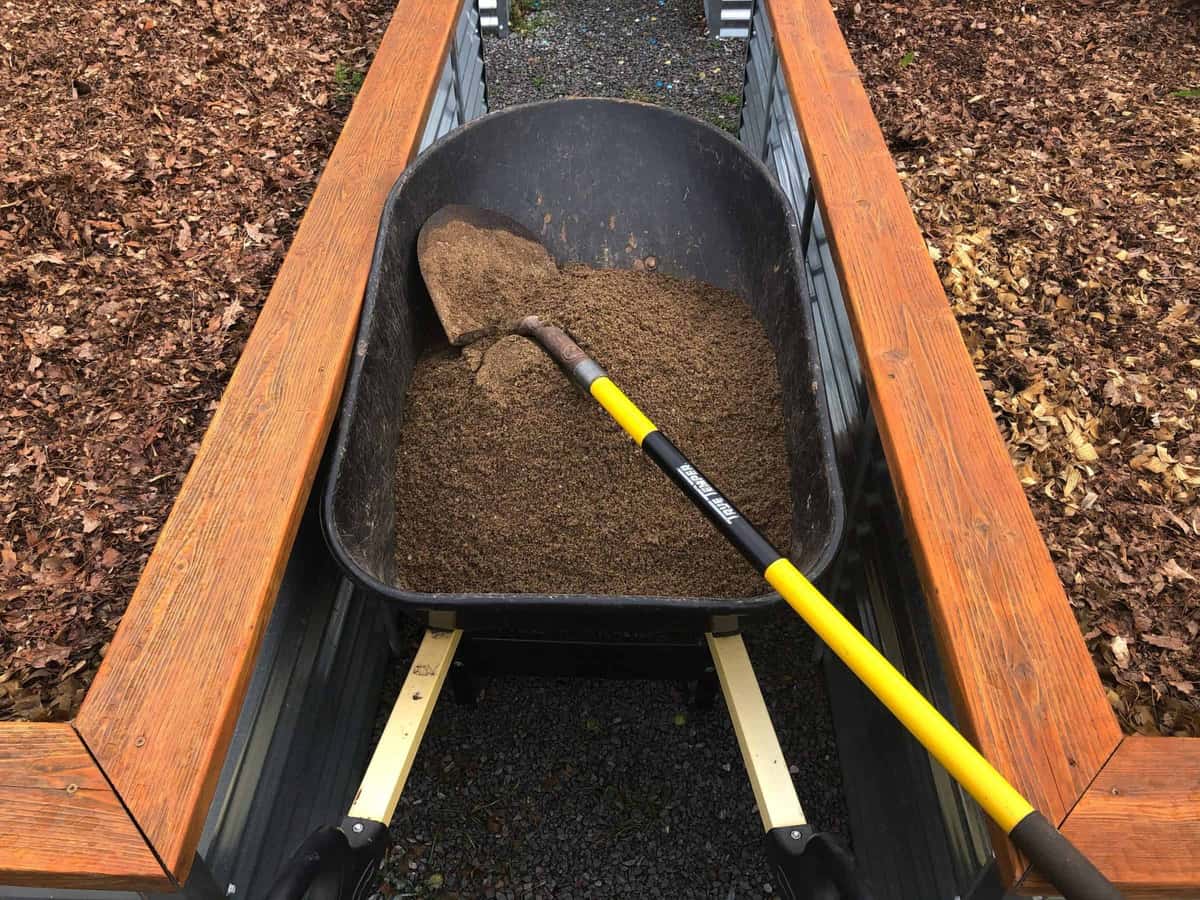
One comment we've gotten frequently on these beds is that they are too high to grow certain crops—like indeterminate tomatoes, corn, and trellis crops like peas and beans. Our plan was never to grow those crops in these beds long term!
We have shorter side beds (13″ high, half a galvanized panel) along the garden fence that work beautifully for beans and peas and even winter squash. We are currently finalizing our garden this year, and the last step is to build six 3′ x 14′ long beds that are made of 12″ high cedar. This is where we plan on growing sweet corn, potatoes, tomatoes, and other large-scale crops.
We originally were going to use the same galvanized steel plan to do the long beds, but changed our mind, mostly because cutting those steel panels in half lengthwise is a pain in the neck! We really didn't want to do it for all the beds in the back, so we went with entirely cedar, which matches the tops of our steel raised garden beds nicely. It ended up being about the same amount cost-wise, but less labor, which is a win! As soon as we're finished building all those beds, I'll shared a photo of the finalized garden. I can't wait!
How To Build Corrugated Metal Raised Garden Beds
Source: https://growfully.com/raised-beds-tutorial-plans/
Posted by: longcomem1980.blogspot.com

0 Response to "How To Build Corrugated Metal Raised Garden Beds"
Post a Comment